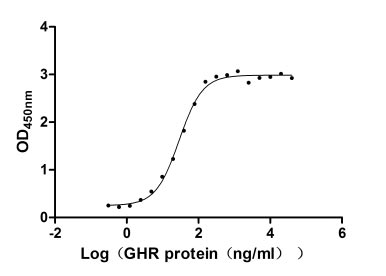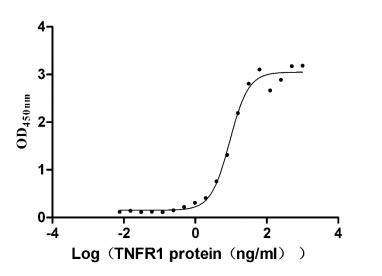Recombinant Saccharomyces cerevisiae Transcriptional repressor OPI1 (OPI1)
-
货号:CSB-YP324292SVG
-
规格:
-
来源:Yeast
-
其他:
-
货号:CSB-EP324292SVG
-
规格:
-
来源:E.coli
-
其他:
-
货号:CSB-EP324292SVG-B
-
规格:
-
来源:E.coli
-
共轭:Avi-tag Biotinylated
E. coli biotin ligase (BirA) is highly specific in covalently attaching biotin to the 15 amino acid AviTag peptide. This recombinant protein was biotinylated in vivo by AviTag-BirA technology, which method is BriA catalyzes amide linkage between the biotin and the specific lysine of the AviTag.
-
其他:
-
货号:CSB-BP324292SVG
-
规格:
-
来源:Baculovirus
-
其他:
-
货号:CSB-MP324292SVG
-
规格:
-
来源:Mammalian cell
-
其他:
产品详情
-
纯度:>85% (SDS-PAGE)
-
基因名:OPI1
-
Uniprot No.:
-
别名:OPI1; YHL020C; Transcriptional repressor OPI1; Negative regulator of phospholipid biosynthesis; Overproducer of inositol protein 1
-
种属:Saccharomyces cerevisiae (strain ATCC 204508 / S288c) (Baker's yeast)
-
蛋白长度:full length protein
-
表达区域:1-404
-
氨基酸序列MSENQRLGLS EEEVEAAEVL GVLKQSCRQK SQPSEDVSQA DKMPASESST TPLNILDRVS NKIISNVVTF YDEINTNKRP LKSIGRLLDD DDDEHDDYDY NDDEFFTNKR QKLSRAIAKG KDNLKEYKLN MSIESKKRLV TCLHLLKLAN KQLSDKISCL QDLVEKEQVH PLHKQDGNAR TTTGAGEDET SSDEDDDDEE FFDASEQVNA SEQSIVVKME VVGTVKKVYS LISKFTANSL PEPARSQVRE SLLNLPTNWF DSVHSTSLPH HASFHYANCE EQKVEQQQQQ QQQQQQQQLL QQQLLQQQQQ KRNKDGDDSA SPSSSVTANG KVLILAKESL EMVRNVMGVV DSTLGKAEEW VKQKQEVKEM IRERFLQQQQ QYRQQQQKDG NYVKPSQDNV DSKD
-
蛋白标签:Tag type will be determined during the manufacturing process.
The tag type will be determined during production process. If you have specified tag type, please tell us and we will develop the specified tag preferentially. -
产品提供形式:Lyophilized powder
Note: We will preferentially ship the format that we have in stock, however, if you have any special requirement for the format, please remark your requirement when placing the order, we will prepare according to your demand. -
复溶:We recommend that this vial be briefly centrifuged prior to opening to bring the contents to the bottom. Please reconstitute protein in deionized sterile water to a concentration of 0.1-1.0 mg/mL.We recommend to add 5-50% of glycerol (final concentration) and aliquot for long-term storage at -20℃/-80℃. Our default final concentration of glycerol is 50%. Customers could use it as reference.
-
储存条件:Store at -20°C/-80°C upon receipt, aliquoting is necessary for mutiple use. Avoid repeated freeze-thaw cycles.
-
保质期:The shelf life is related to many factors, storage state, buffer ingredients, storage temperature and the stability of the protein itself.
Generally, the shelf life of liquid form is 6 months at -20°C/-80°C. The shelf life of lyophilized form is 12 months at -20°C/-80°C. -
货期:Delivery time may differ from different purchasing way or location, please kindly consult your local distributors for specific delivery time.Note: All of our proteins are default shipped with normal blue ice packs, if you request to ship with dry ice, please communicate with us in advance and extra fees will be charged.
-
注意事项:Repeated freezing and thawing is not recommended. Store working aliquots at 4°C for up to one week.
-
Datasheet :Please contact us to get it.
靶点详情
-
功能:Negative regulator of the transcriptional complex INO2-INO4 in response to phospholipid precursor availability. When precursors become limiting, OPI1 is retained at the endoplasmic reticulum (ER) and INO2-INO4 activates INO1 and other genes required for phospholipid biosynthesis, whereas abundant precursor availability results in targeting of OPI1 to the nucleus to repress transcription of these genes. Binds directly to phosphatidic acid, which is required for ER targeting and may act as sensing mechanism for precursor availability, as phosphatidic acid becomes rapidly depleted upon phospholipid biosynthesis.
-
基因功能参考文献:
- The work shows that transcriptional repressor Opi1p is redox-regulated and establishes a new mechanism of gene regulation involving Opi1p, which is important for adaptation to H2 O2 in yeast cells (Saccharomyces cerevisiae). PMID: 28581036
- This study demonstrated that Pho85 binds to Opi1 in vitro and in vivo and that this interaction is increased in the presence of high concentrations of phosphate. PMID: 27743455
- Opi1p dissociates from Scs2p after targeting to the nuclear membrane, making it possible to be released from the membrane quickly when phosphatidic acid levels decrease. PMID: 26590299
- genes of phospholipid biosynthesis are negatively regulated by repressor protein Opi1 when precursor molecules inositol and choline are available. Opi1-triggered gene repression is mediated by recruitment of the Sin3 corepressor complex. PMID: 22543816
- demonstrate that a physical association between the Yet complex and Scs2p-Opi1p is required for proper localization of the Opi1p repressor to endoplasmic reticulum membranes and subsequent INO1 derepression PMID: 21372176
- a rapid decrease in intracellular pH in response to glucose starvation regulated binding of phosphatidic acid to Opi1, that coordinately repressed phospholipid metabolic genes; this enabled coupling of membrane biogenesis to nutrient availability PMID: 20798321
- Two of the mutations in OPI1 (V343Q and S339F) provide genetic evidence for an interaction between Opi1p and the Ino2p activator since they reside in a region of Opi1p recently shown to interact with Ino2p in vitro. PMID: 16322993
- casein kinase II phosphorylation at Ser10 plays a role in stimulating the repression of INO1 when Opi1p was not in its most active state PMID: 16407309
- To better understand the mechanism of Opi1p repression, the viable yeast deletion set was screened to identify Opi(-) mutants. In total, 89 Opi(-) mutants were identified, of which 7 were previously known to have the Opi(-) phenotype. PMID: 16582425
- This study revealed that a transcription factor that controls INO1 expression, called Opi1p, participates in the regulation of mat formation. Opi1p appears to modulate mat formation by influencing the expression of FLO11. PMID: 16896211
显示更多
收起更多
-
亚细胞定位:Endoplasmic reticulum. Nucleus. Note=Maintained at the endoplasmic reticulum by SCS2 (PubMed:12727870). In response to elevated inositol levels, translocates to the nucleus (PubMed:15192221).
-
数据库链接:
KEGG: sce:YHL020C
STRING: 4932.YHL020C
Most popular with customers
-
Recombinant Human Growth hormone receptor (GHR), partial (Active)
Express system: Mammalian cell
Species: Homo sapiens (Human)
-
Recombinant Human Transthyretin (TTR) (Active)
Express system: Mammalian cell
Species: Homo sapiens (Human)
-
Recombinant Human Tumor necrosis factor receptor superfamily member 1A (TNFRSF1A), partial (Active)
Express system: Mammalian cell
Species: Homo sapiens (Human)
-
Recombinant Dog Angiopoietin-2 (ANGPT2) (Active)
Express system: Mammalian cell
Species: Canis lupus familiaris (Dog) (Canis familiaris)
-
Recombinant Human Claudin-6 (CLDN6)-VLPs, Fluorescent (Active)
Express system: Mammalian cell
Species: Homo sapiens (Human)
-
Recombinant Human Claudin-3 (CLDN3)-VLPs (Active)
Express system: Mammalian cell
Species: Homo sapiens (Human)
-
Recombinant Human CUB domain-containing protein 1 (CDCP1), partial (Active)
Express system: Mammalian cell
Species: Homo sapiens (Human)
-
Recombinant Human Interleukin-2 (IL2) (Active)
Express system: Mammalian cell
Species: Homo sapiens (Human)






f4-AC1.jpg)













